October 1, 2015 is the deadline for 500-word abstracts of proposed chapters.
Editors: Karen Keifer-Boyd, Linda Hoeptner-Poling, Sheri Klein, Wanda B. Knight, and Adetty Pérez de Miles.
Beyond the National Art Education Association’s Women’s Caucus (NAEA WC) sessions, meetings, and events that reside within the formal institution of the NAEA, the Women’s Caucus Lobby session is an annual event held in the lobby of the “headquarters” hotel for the NAEA Convention. Significance aspects of the Lobby session include self-introductions to someone you have never spoken to before, creative prompts for small group discussion about current issues, and human mic amplification as public performance in the hotel lobby. The “speak-out” affirmation of our beliefs and actions is recorded, transcribed, and posted with photographs online at http://naeawc.net/
Our goal is publication of the anthology by the 2018 NAEA convention as a 10th anniversary of the NAEA Women’s Caucus Lobby Activism. Below are descriptions of the 10 sections of the book with guidance for chapter submissions to one or more of the book sections. Submit proposals here. Send queries to the lead editor Karen Keifer-Boyd at kk-b@psu.edu. Co-editors include Linda Hoeptner-Poling, Sheri Klein, Wanda B. Knight, and Adetty Pérez de Miles.
We also encourage all participants at our Lobby sessions to create art and write about what was awakened at the Lobby session as submissions to the Lobby Activism book. Sheri Klein did just that in her drawing created in response to a question about identity posed at the 2011 Lobby: “When did you first feel like an art educator?”
Questions/Prompts:
2018: Activism
2017: Entanglement
2016: Feminist Leadership
2015: How do you (re)deSIGN gender codes in your teaching, art, and life?
2014: Speak Truth to Power
2013: What are my personal responsibilities and our collective responsibilities to end violence?
2012: What do you believe is critical to lobby for in 2012
2011: A Time When …
2010: What is the Image of a Feminist in the Field of Art Education Today?
2009: Enacting Change: What We Can Learn From Each Other?
2008: Collaborative JAE publication: “Vote 2008: What Should an Art Educator Do?”
A summary of past Lobby sessions conveys the NAEA WC’s resolve to identify current injustice and collectively work to eradicate discrimination. Each year our attendance at these Lobby sessions has increased, with more than 75 participants in attendance at recent Lobby sessions.
2017 Entanglement
2016 Feminist Leadership
Feminist leadership initiates, organizes, dialogues, distributes, transforms, and collaborates. Feminist leadership movement is not hierarchical but instead is horizontal, entangled, and intersectional. Feminist leadership legitimizes situated knowledge and recognizes diverse positionalities. Feminist leadership can be everyday actions or passionate activism that advances social justice. This section of the Lobby Activism book invites chapters of feminist leadership in art education. Examples include Judy Chicago’s circle pedagogy, Linda Stein’s Holocaust Heroes: Fierce Females tapestries, and art teachers who are transformational in their schools and communities.
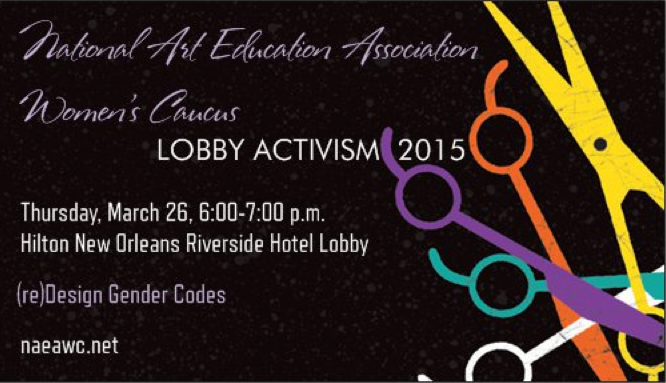 2015 New Orleans: (re)deSIGN Gender Codes
2015 New Orleans: (re)deSIGN Gender Codes
How do you (re)deSIGN gender codes in your teaching, art, and life?
Forms of gender identity that, by design, resist the man/woman binary are unimaginable to many people. As Judith Butler (2004) puts it, “To find that you are fundamentally unintelligible (indeed, that the laws of culture and language find you to be an impossibility) is to find that you have not yet achieved access to the human, to find yourself speaking only and always as if you were human, but with the sense that you are not because the norms by which recognition takes place are not in your favor” (p. 30). [Butler, J. (2004). Undoing gender. New York City, NY: Routledge.]
Many scholars, activist, and educators agree that it is vital to create opportunities that extend complex understandings of gender identity. This section of the book is open to a multiplicity of explorations that (re)deSIGN binary-based constructions of gender in research, teaching, art, and life, for example, but not limited to:
How do you (re)deSIGN:
- Research through the lens of feminist, queer, and transgender theories to raise thought-provoking questions about relationships of power
- Curricula to explore feminist and LGBTQ topics, issues, and concerns
- Pedagogical practices to support gender diversity and inclusive environments
- Forms of critique and analysis to focus on non-conforming gender and sexual expression(s) in art, visual, material, and popular culture
- Contemporary understandings of social/locative media, mobile gaming, cyber/virtual worlds, and emerging media technologies to trouble persistent sexist ideologies and practices in visually mediated research, data, and technologies
- Research through narrative inquiry, ethnography, phenomenology, performance, case studies, or post-qualitative methodologies to broaden the definition of diversity by focusing gender non-conforming methodological approaches
- Frameworks to problematize the creative industries, digital labor, immaterial labor, communicative capitalism, and the “participatory” museum, as these ideas are connected to neoliberal and post-Fordist economic models in relation to gender identity.
- Ethical responsibility in working with LGBTQ communities
- Art, research, curriculum, and activist projects to improve the quality of life of a wide range of learners and diverse gender variations
- Approaches to Queer and Transgender the academy
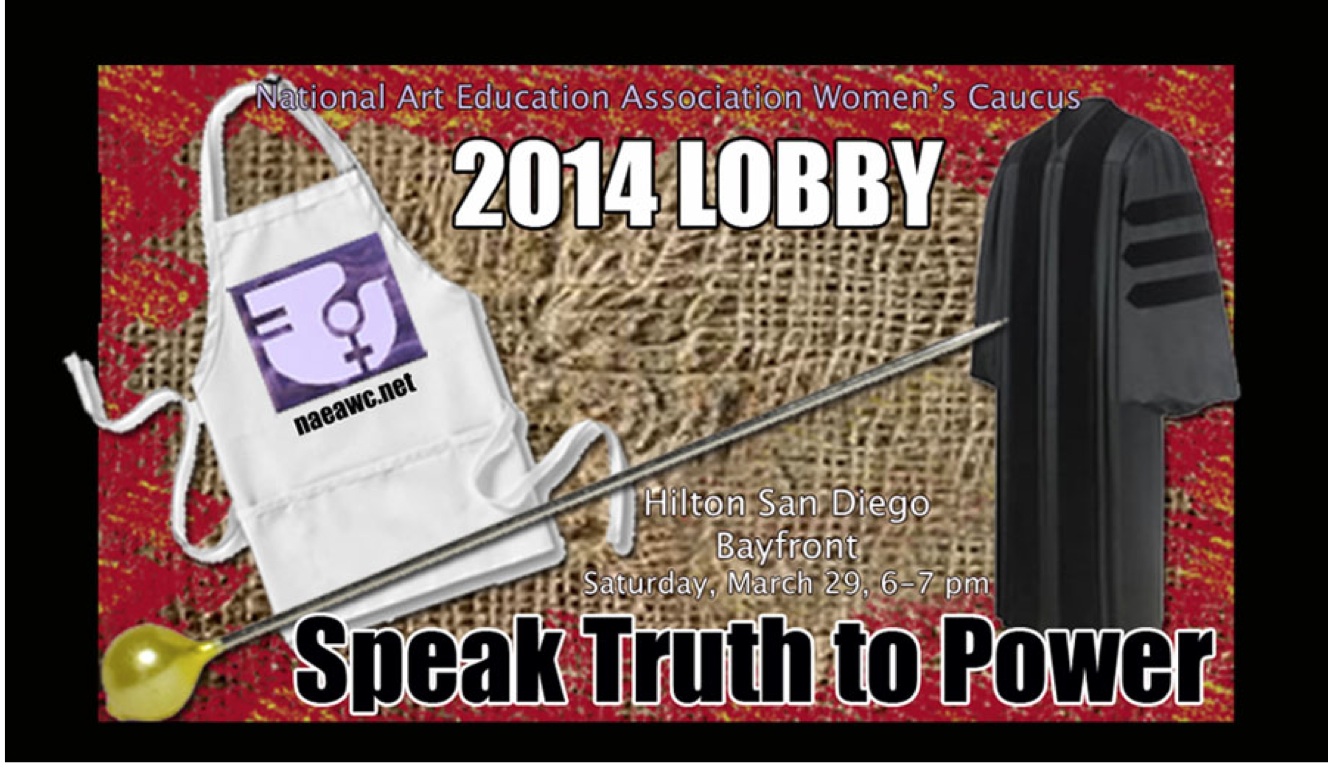 2014 SAN DIEGO: SPEAK TRUTH TO POWER
2014 SAN DIEGO: SPEAK TRUTH TO POWER
“Speak Truth to Power” is a phrase adopted by or applied to those who challenge dominant forces—namely, patriarchy and capitalism. Barbara Kruger’s artwork Speaks Truth to Power. (Smithsonian magazine, July 2012). Kruger refashions idioms, as Judy Chicago does in her Resolutions: A Stitch in Time, 1994-2000 series.
In Chicago’s Retrospective in a Box series, 2009-2013, printed by Landfall Press, her work “Aging Woman/Artist/Jew” from 2013 speaks truth to power. Next to the work is Chicago’s artist statement:
As always, I wanted to challenge stereotypical attitudes, particularly those that consign older women to an undesirable, nonsexual and declining existence, replacing this mean-spirited view with a fiery image of a woman whose body may be succumbing to the aging process, but whose spirit remains strong and her identity clearer than ever before.
In Chicago’s self-portrait, her mouth is filled, where teeth would be, with capital letters: “TRUTH.” For more than a half-century, from The Dinner Party created in the 1970s to the 2013 self-portrait, Judy Chicago has been speaking truth to power. Judy Chicago’s spirited work speaks volumes to artists, educators, and scholars who seek feminist perspectives and practices.
2014 Lobby participants spoke truth to power by writing or drawing on strips of fabric then pinning the message on either an artist’s apron or academic gown. A human mic practice amplified the group speaker, speaking truth to power.
The artist apron symbolizes feminist power. While aprons have been associated with housework, the artists’ work apron symbolizes both the intellectual work and labor of artistic production. The academic gown symbolizes patriarchal power, and the hierarchies within educational institutions that often run counter-productive to creating equitable and just teaching, learning, and working environments. The 2014 Lobby session process is linked here.
We invite chapters for this section of the book that speak truth to power through art and/or art education.
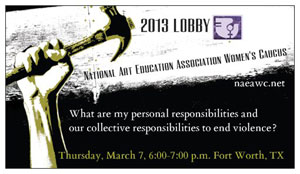 2013 FORT WORTH: What are my personal responsibilities and our collective responsibility to end violence?
2013 FORT WORTH: What are my personal responsibilities and our collective responsibility to end violence?
The presence of violence in our culture is pervasive, all too commonplace and is reflected in ongoing global reports of suicide, murder, rape, animal and human rights violations, school and workplace violence, violence against women and girls, hate speech and proliferation of imagery generated in the media. This section explores ways that art educators can, one step at a time, disrupt the chain of violence through pedagogy, service, community work, activism and other forms of resistance. The guiding question for this section is: What is our individual responsibility and our collective responsibility to end violence?
The 2013 Lobby session process is linked here.
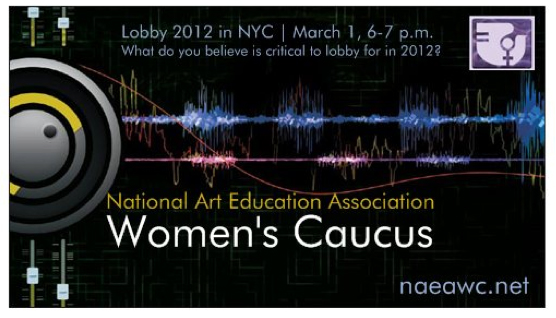 2012 NEW YORK: What do you believe is critical to lobby for in 2012?
2012 NEW YORK: What do you believe is critical to lobby for in 2012?
In response to the prompt, more than 60 participants formed groups and each of the five groups created posters.
It goes without saying that the social milieu of our times is wrought with complication, contention, and challenge. The U.S. presidential election of 2012 certainly highlighted many issues with which to contend, and these issues evolve and expand with time, many intimately connected to feminism. Prior to 2012, NAEA WC leadership collected data in 2010 via the “Survey of Art Educators’ Perceptions of and Relationship to Feminism” (http://naeawc.net/survey.html). As stated in the survey, “[t]he purpose of this survey [was] to learn of art educators’ perceptions of and relationship to feminism in their work in the field of art education today. What are the reasons that art educators identify with or reject feminism? What are the differences of ideology and teaching practices between those who consider themselves to be feminists and those who don’t?” In other words, what do you believe is critical to lobby for, within the lenses of feminism(s) today? Balancing the personal and the professional is certainly not achieved without challenge, challenge that requires us to make choices about competing demands. This section explores how and why we as feminist art educators decide where to put our activist energies both in and outside of the classroom at all levels of education, in addressing competing demands posed by issues of both personal and broader social landscapes of feminist activism.
Questions to guide this discourse and engagement:
- What does it mean to lobby for feminist issues in art education and beyond?
- How do we spend personal and professional energy as activists?
- What issues drive our decisions, actions, and intentions in lobbying for what we believe is critical?
- How do activist stances inform and impact our art education (feminist) practice?
About 50 people assembled to share personal experiences as possible pedagogical or collective actions. Themes emerged such as feminization of art education, gender inequity, reinventing self, and enacting beliefs. A Time When … prompts linked here.
Transcript of the 2011 session linked here.
Our identities are shaped by a myriad of experiences, people, events and intersecting factors, such as, gender, race, ethnicity, class, religion, sexuality, and vocation. In this sense, the word “identities” describe a dynamic and evolving construction of our personal and professional lives that intersect with tensions and conflict. Teacher and professional identity has been the focus within educational narrative inquiry to better understand how teachers’ conceptualize their work and navigate the personal, professional, pedagogical and political. The guiding theme of: “A time when…” points to a moment or time of identification with the profession, or role of art educator. It may also signal a time when one’s position or perceptions of self have shifted due to structural, economic and global forces in ways that consider one’s positionality.
2010 BALTIMORE: What is the Image of a Feminist in the Field of Art Education Today?
The 2010 Lobby Session extended the “Survey of Art Educators’ Perceptions of and Relationship to Feminism.” Of the 123 respondents to the survey, of which 104 identified as women, 100 reported that they had experienced gender discrimination. Transcript of the 2010 session linked here. Photos from 2010 Lobby session.
In part, goals of feminism and feminist pedagogy are: to create gender equity through empowerment of students; to create gender equity through creating community or communal classroom spaces; the embodiment of shared leadership, collaboration and cooperation; the practice and knowledge of disciplines that intersect many facets of cultural identifiers; and, to create meaningful ways to engage students in critical thinking and inquiry about topics of gender issues, including inequality, privilege, and power. Working towards equity, questioning assumptions, and engaging in reflective practice, we invite a multiplicity of expression in reconceptualizing the aims of feminism and feminist pedagogy in art education for contemporary times.
Questions to guide this discourse and engagement:
- What are the forms, language, and knowledge of feminism, feminists, and feminist pedagogy in art education today and of the past?
- How does one work towards equity in art education?
- What critical transgressions of the past inform today’s momentum in art education?
- How do we define feminist pedagogy in art education? Does it look/feel/read differently today than the forms practiced by feminists that forged openings and opportunities available today?
- What feminist critical transgressions need to be considered and conceptualized at all levels of art education?
- What forms can the telling, recording, performing, and imagining of contemporary feminist pedagogy take that will (re)voice the lexicon of art education?
- Who in art education practice feminism and feminist pedagogy? How is their impact felt?
2009 MINNEAPOLIS: Enacting Change: What We Can Learn From Each Other?
A suggestion from the 2008 lobby session for the Women’s Caucus to organize mentor relationships was the topic in 2009. Read responses to what the participants wanted to hear about each other’s experiences in the transcript of 2009 session linked here.
The Women’s Caucus/NAEA membership draws individuals who are committed to advancing feminist perspectives and practices and envisioning, creating, and co-creating new ways of being, relating, teaching, and leading that promote diversity, inclusivity, equity, and personal and social change.
The richness of our community is evidenced in the myriad of our diverse experiences and NAEA WC members who are at very different stages of a professional life. The guiding question for this section is: What can we learn from one another? Possible topics for this section of the Lobby Activism book might include:
- Professional practice, such as, leading, mentoring, activism, building networks of support, developing a voice in teaching and research, balancing personal and professional lives, coping with loss, disappointment and moving through the transitions and cycles of one’s professional life (e.g., from new faculty to tenure, mid career, and from professional practice to retirement).
- Reflecting on how we can learn from one another via technology is also relevant in our time of a networked society and can provide new approaches and avenues for teaching, mentoring, leading, activism, reaching out, and sharing with others.
2008 NEW ORLEANS: “Vote 2008: What Should an Art Educator Do?”
Participants collaborated in a response to the prompt for a strategic essay published in the Journal of Art Education (Copyright July 2008. Used with permission of the National Art Education Association). Meeting notes linked here.
In March of 2008, a group of art educators met at the NAEA Conference in New Orleans to discuss the presidential election as a source of active learning and critical investigation. President Barack Hussein Obama was elected the first African-American president of the United States in November 2008 and re-elected to a second term in 2012. The most memorable images of Obama, as W.J.T. Mitchell (2009) reminds us, “were produced by members of the movement he catalyzed, not by his professional image-makers” (p. 127). Some examples of this phenomenon include, Shepard Fairey’s “Hope” poster and obama-icon-me—a DYI Web App that allows individuals to upload self-portraits to create posters of her or his image in the style of Fairey’s depictions of president Obama. But not all visual representations of president Obama have been positive. Despite claims of racial progress and becoming a post-racial society, overt and symbolic racist stereotypes (joker, chimp) and Othering (Muslim and non citizen), in the form of visual representations, ensued. Today, we are gearing up for the 2016 presidential election. Hillary Rodham Clinton has entered the race as a front-runner for the presidency. One can only imagine the (re)presentations that will permeate media culture surrounding the Clinton campaign. The salient point is that visual culture is omnipresent and plays a role in our everyday decisions from the products that we consume to important decisions about “whom we elect to govern us” (Howells & Negreiros, 2012, p. 4).
The guiding question for this section of the book is: What Should an Art Educator Do? Reflecting on the past (Vote 2008), looking forward to the future (Vote 2016), and envisioning an aesthetic or socio-political time where the knots of time and space are untied (the latter, is open to interpretation). Papers may be closely or broadly related to the guiding question, and include a wide range of sites of investigation, such as film, art, images, photos, newsprint, literature, poetry, historical records, archival materials, graphic novels, social media, virtual reality, and emergent media culture/technologies. Central to this section is to analyze the ways that visual practices shape and inform discourses related to our art, research, teaching, curriculum, activism, or pedagogy—mediations that fuel our pleasures, displeasures, play, fears, desires, and hopes as refracted in the contextual specificity of the time, space, and place that we occupy. Chapter submissions might focus on (re)presentation, image-makers, making images, and practices of looking or visuality. Broadly conceived, visuality encompasses the ocular, but also the sonic, the sensorial, the material, the embodied, and incorporeal, as well as the human and post-human.
******
The editors for all sections of the Lobby Activism book encourage submissions that have a feminist/critical race theoretical lens with research designs and presentation forms that might include arts-based research, performance-based research, narrative inquiry, ethnography, interview, case study, photo/visual essays, and documenting activist work based on the Lobby prompts.
We invite all NAEA members to come to and participate in our annual Lobby sessions, typically held in the lobby of conference hotel at 6:00 p.m. on the first day of the conference.
October 1, 2015 is the deadline for 500-word abstracts of proposed chapters.
SUBMISSION DETAILS
Proposal Format: Prospective contributors will submit a 400-500 word abstract with at least five references from relevant literature and a chapter title, author name, affiliation, and contact information (phone, e-mail and mailing address).
Procedures: Please upload the proposal as a Word file here. All submitters will be notified by December 1, 2015 of the status of their proposal. Authors of selected proposals will receive chapter guidelines and will be invited to submit full chapters for consideration by October 1, 2016. Editors will review submitted chapters for final selection and make recommendations for revisions by December 1, 2016. Final submissions will be due by January 1, 2017. The Lobby Activism anthology will include chapters that form the 2016, 2017, and 2018 Lobby Activism themes. Our goal is publication of the anthology by the 2018 NAEA convention as a 10th anniversary of the NAEA Women’s Caucus Lobby Activism. Send queries to the lead editor Karen Keifer-Boyd at kk-b@psu.edu. Co-editors include Linda Hoeptner-Poling, Sheri Klein, Wanda B. Knight, and Adetty Pérez de Miles.
IMPORTANT DATES
October 1, 2015: Proposal Submission Deadline
December 1, 2015: Notification of Proposal Acceptance and Invitation to Submit Chapters
September 1, 2016: Full Chapter Submission
December 1, 2016: Notification of Acceptance and Revisions Returned
January 1, 2017: Final Chapter Submission
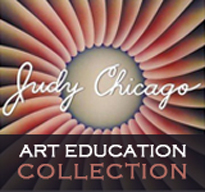
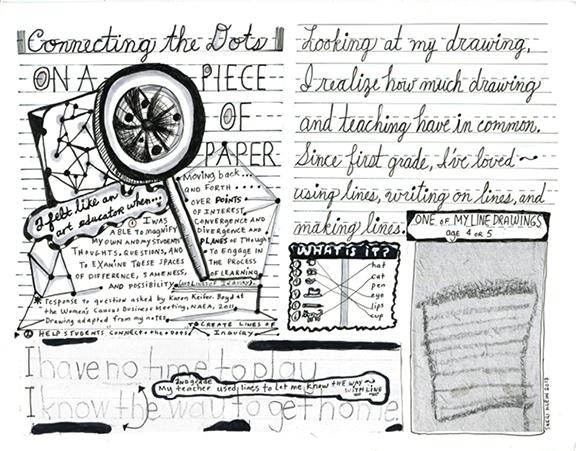
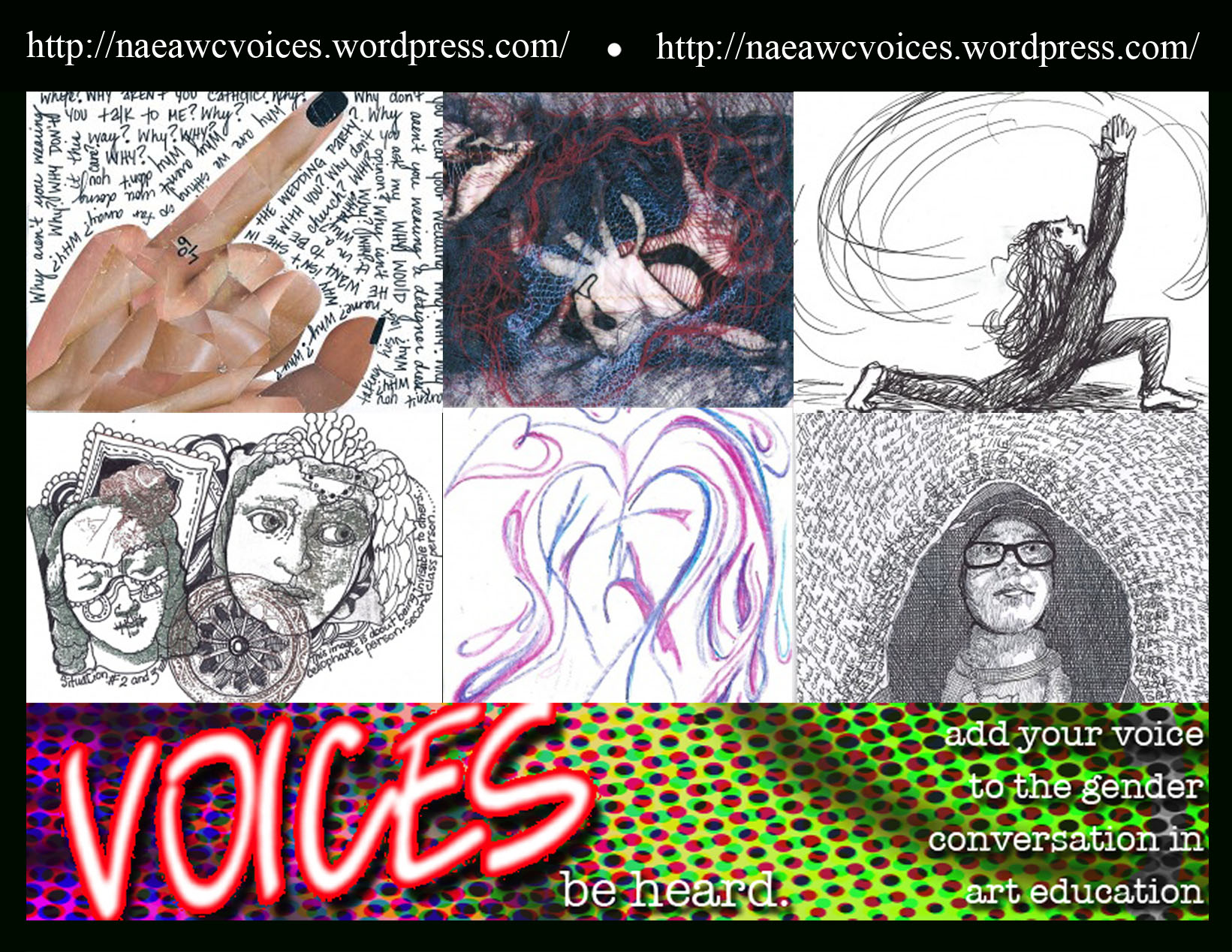
Leave a Reply
You must be logged in to post a comment.